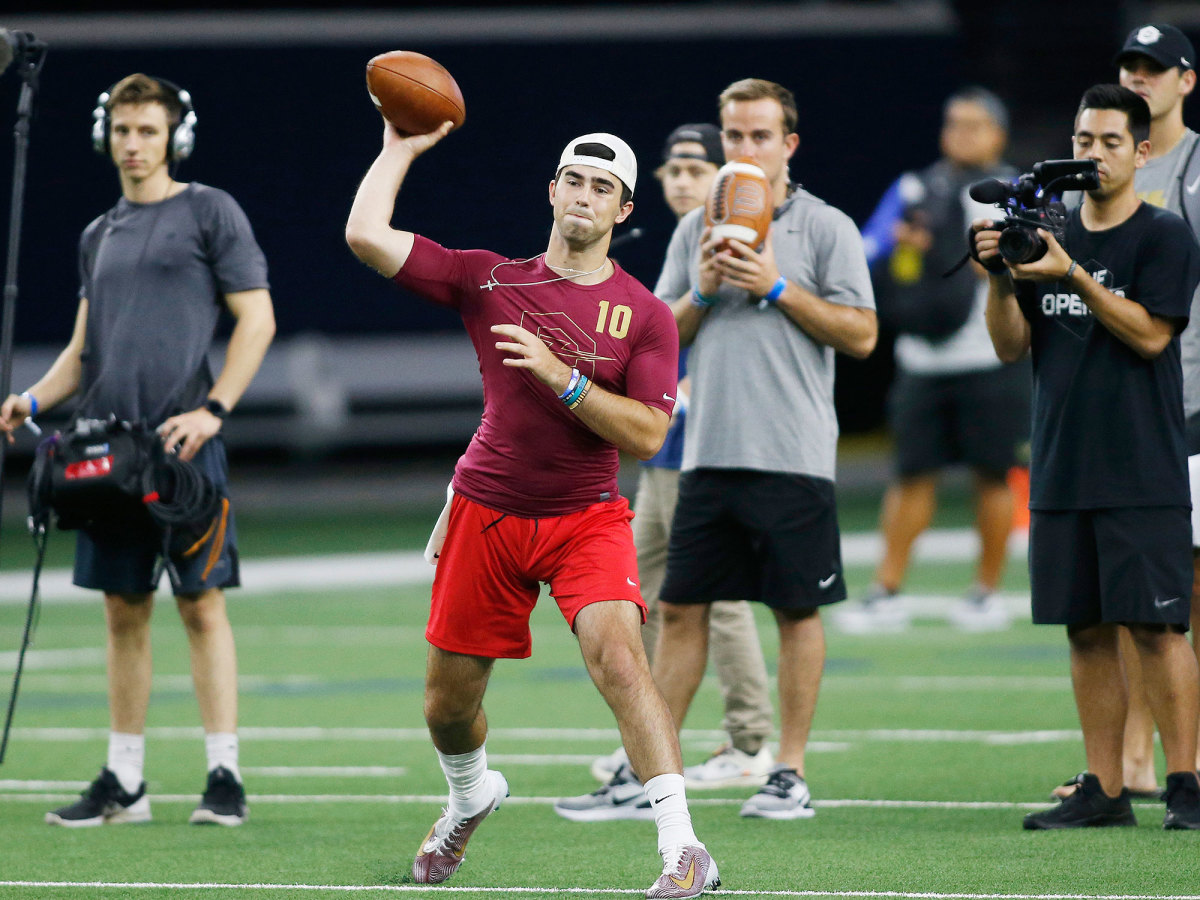Inside the Upside-Down World of College Football Recruiting During a Pandemic
Miller Moss had big plans for this spring and summer. One of the top quarterback recruits in the nation, Moss had scheduled campus visits to both LSU and Alabama, wanted to watch hometown programs USC and UCLA hold spring practice, and was set to participate in the preeminent high school quarterback event, Elite 11. At some point along the way, certainly by the time summer ended, he planned to publicly commit to a university.
The coronavirus pandemic shattered all such plans. Like so many during this near nationwide shutdown, Moss’s future is cloudy. His next move is uncertain. “I was hoping to make a decision in the next couple months,” he says during a phone conversation this week from his Los Angeles home. “I want to lock in where I’m going to school, but I won’t make any preemptive decision. It’s set my timeline back.”
The month of April normally kicks off what experts might consider the busiest evaluation period on the recruiting calendar. Stretching through most of June, this three-month term is chock full of significant events, many of them integral to the relationship-building portion of the recruiting process. It is a critical time in which coaches seriously begin scouting rising juniors while making final decisions on rising seniors; players for the first time tour campuses and work out in front of recruiters; and schools distribute thousands of scholarship offers.

All of the above is rooted in something so rudimentary but currently absent: in-person interaction. The shutdown has now relegated all communication to FaceTime, Zoom and text. At the start of the outbreak last month, the NCAA created a recruiting dead period through May forbidding in-person contact between coaches and prospects—on or off campus. One Power 5 athletic director told Sports Illustrated earlier this week that the NCAA may extend the dead period through August, and already several schools have canceled prospect camps scheduled for June. “Everybody is focusing on it from a coaching perspective, but it’s a lot more difficult for the player going through this,” West Virginia coach Neal Brown says.
The virus has stripped rising seniors like Moss of a critical piece to a recruiting process that in some cases started more than two years ago. But what hurts the player directly impacts the coach as well. The shutdown is forcing coaches to miss at least three “data points” for each prospect, Brown says. A two-year recruitment can include about 12–15 data points per prospect, interactions such as meetings with players on campus during weekend visits, evaluating them while on a spring trip to their high school and watching them during summer camp competitions.
The absence of such events are wide-ranging. Many industry insiders expect a record number of decommitments in the fall and winter, as panicked prospects and their families, uncertain about the fall, rush to commit only later to renege. “It’s going to be a mess, but if you do your homework, you’ll lose a couple and might gain a couple,” says Arizona State coach Herm Edwards. “It is what it is.”
Other prospects, like Moss, are doing the opposite, their recruiting momentarily frozen with boxes left to uncheck before a decision date. Either way, this could create one of the busiest fall recruiting seasons in recent history, experts predict. Prospects who scheduled spring official visits will move them to the fall. Coaches who normally used spring for evaluation will scout Friday night high school games, a day before their current players compete in a game—that is, if the season even proceeds as normal. “It’s hard,” Brown says. “The first priority is to win the games you’re playing.”
But maybe the No. 1 impact of the virus on recruiting comes in proximity of signees to their colleges, says Christian White, a private trainer in the Dallas area who’s immersed in the recruiting world. Colleges could sign more local kids than ever. With no chance to visit cross-country schools for four months, prospects will stick to what they already know: their nearby university. “It’s going to make it a regional class,” says White. “Kids staying close to home because it’s the only places they've been able to see so far. I had a college coach tell me, ‘We’re going to focus on the kids on this side (of the state) this year because those are guys who have been by here and seen campus.’”
Recruiting is an inexact science, but this cycle, the science is just plain messy. “Everybody in the country, the margin for error is growing a little bit,” says one SEC staff member who wished to remain anonymous. With a long-term loss of three key periods in the recruiting calendar—on-campus visits, summer camps and spring evaluations—college coaches are learning to recruit from afar, mostly through their phones and computers. They’re watching more film, conducting virtual visits with prospects and, with their football duties mostly suspended, communicating with recruits more than ever. Some coaches say they speak to two dozen prospects every afternoon and evening. When they’re not talking to them, they’re watching them in old game videos. “I was reading something about the NFL and how they're going to go back to what should be the primary thing you look at when evaluating and that’s the game tape,” Tulane coach Willie Fritz says. “Everybody gets into the underwear olympics—see how tall and fast they are. It comes down to is the guy a football player?”
That said, camps might be missed the most. Camps supply two data points for the price of one: (1) prospects compete in a one-on-one or 7-on-7 setting and (2) they visit the college campus, sometimes staying an entire weekend. Coaches also use camps to gauge the character of a prospect and vice-versa, says Charlotte coach Will Healy, whose school, in the early stage of FBS membership, holds what he calls 'mega-camps' to grow its brand. “They see how we run things, and we see … is the guy the right culture fit if you can’t coach him in camp?” he says. “You want to challenge them and see how they respond to adversity. Then they know what they’re signing up for when they get there.” Camps give prospects a better idea of where they stack up at their position on a staff’s pecking order, says Danny Hernandez, a private quarterback coach in California. “You can see if a guy is loved up more than you. Let’s you know where you fall in line. That plays into your decision,” he says.
Commitment decisions are often made in droves during and after camps, and offers are doled out in mass, too. Some coaches make offers before camp that are contingent on a prospect visiting camp. “You’ll offer a guy and say, ‘Here’s an offer but you have to come to camp,’” a Power 5 assistant says. “Well, what do you do if there are no camps, because I can tell you right now, there aren’t going to be any camps. All the offer is, is like a reservation at a restaurant. It means you have a table, but you have to show up.” In fact, DJ Mann, the recruiting coordinator at Dallas-based powerhouse Cedar Hill High, has two players in such a predicament. He recently asked the coaches if the players’ offers were valid with camps canceled, or soon to be canceled. “I really didn’t get an answer,” he says. “It’s unchartered territory.”
Starting this weekend, air routes and roadways would normally be clogged with hundreds of college coaches en route to prep schools. The now-suspended six-week spring evaluation period, usually starting in mid-April and running through May, gives coaches the ability to visit a recruit’s high school for academic and athletic evaluation. They pore over transcripts, watch a prospect compete in spring practice or strength training and meet with a wide variety of people—guidance counselors, school principals, coaches and teachers.
At Cedar Hill High, more than 100 college coaches normally cycle through spring football practice in May, says Mann. He expected 30 players to sign with schools this cycle, and while that’s still a possibility, he had anticipated as many as 10 of those players receiving offers from evaluation visits in May. “We rely on our rising juniors to get offers in spring when coaches visit because we play a lot of seniors during the season,” he says. “No spring hurts my kids who don’t have a lot of game film.” There could be an alternative solution, says Arizona State’s Edwards: an August evaluation period. Edwards believes the NCAA could lift the normal dead period during that month to replace evaluation time lost in spring, allowing player visits to campus and coaching visits to high schools. It might be a long shot.

Other cancellations are impacting the recruiting process, too. Most 7-on-7 leagues, another outlet for players to produce film for college recruiters, didn’t complete even half of their tournaments. The shutdown is also impacting recruits in another way: a lack of attrition from current rosters. The height of transfer season normally exists between the end of spring practice and the start of fall camp. Spring drills often reveal to players where they exist on a depth chart, triggering many to find other options and creating space for either signees or incoming transfers. “That isn’t happening as it was in the past,” says Hernandez. “Everybody is hanging tight and nobody knows where they’re going to fit in. I have some guys in college in that situation, fighting to see if they’re going to at least be a No. 2, but they don’t know. You’re going to have to base a lot on fall camp. Those guys are going to get stuck.”
But maybe there are positives to all of this, too. Coaches, usually encumbered with spring practice and then on the road in May, have more free time to get a head start on the 2022 class. “They’re getting more offers out,” Hernandez says. “The 2022s have benefited in this whole thing.” Coaches also have more free time to call recruits, establishing better relationships with prospects and their families while also filling up their phones. “I wake up and I have a full page of text messages,” Moss says. “I don’t see that as an issue. I think it’s expected—no spring ball and coaches are at home.”
Moss is stuck in his home in Mission Hills, a community in the northern part of Los Angeles, but he feels like one of the lucky ones. He’s visited a dozen or more college campuses over the last two years, traveling with his parents on regionally based recruiting tours—the east coast, the southeast and the midwest. Moss has seen every campus he needs to, he says, except one: LSU. And that means his recruitment just got a whole lot longer. “It’s unfortunate. It’s never something anybody would anticipate. ‘What if the world shuts down and everyone has to stay at home?’” he says. “I’m confident I’ll end up at the school I’m supposed to.”
More From SI.com Sites:
Miller Moss Blog: Life, Recruiting, and Coming Full-Circle
No. 1 QB Caleb Williams on Secret Sauce, Working on His 'Tom Brady'
